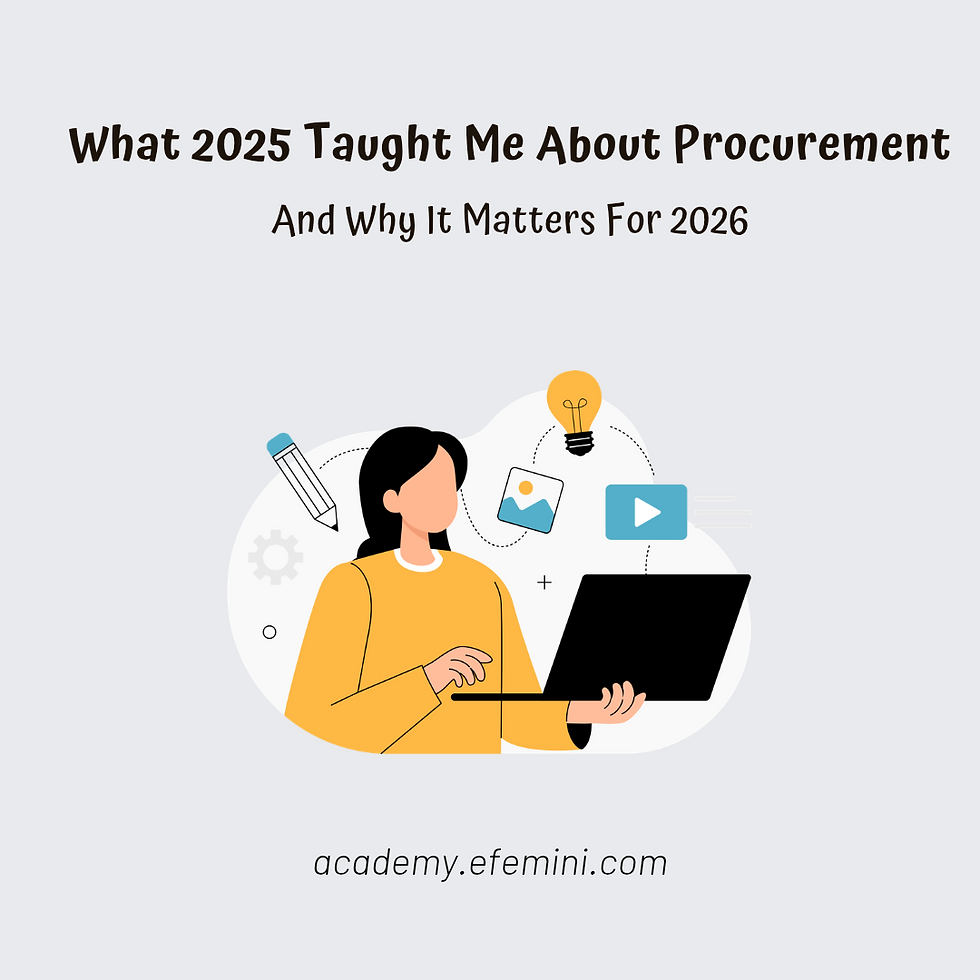How I Convinced Stakeholders to Support a Bold Procurement Strategy
- Efemini

- Jun 7, 2025
- 3 min read
The tension in the room was undeniable.
But understandably so. I had just proposed a bold procurement strategy.
The idea of overhauling our procurement model; consolidating vendors, introducing strict competitive bidding practices and supplier performance structures wasn’t an easy one to take in all at once. However, I knew that to drive cost savings and significantly improve efficiency will require a shift from the status quo.

My biggest challenge? Convincing skeptical stakeholders who were comfortable with the old ways. Change certainly feels risky, especially when procurement touches every part of the business.
Prior to this time, our procurement process relied on long-standing supplier relationships, minimal contract negotiations and little innovation.
But rising costs and stagnant supplier performance signaled the need for change. Urgent change. My proposal introduced vendor consolidation, competitive bidding and supplier performance incentives, ideas that Finance, Operations, and Leadership found risky.
Stakeholders feared supplier disruptions, quality issues and too much uncertainty. Rather than dismiss their concerns, I tackled them head-on, knowing that logic alone wouldn’t win them over.
Firstly, I spoke their language
Instead of saying: “We’ll reduce supplier count by 40%”
I said: “We’re spending $X managing 80+ vendors in one category. By streamlining, we’ll be able to cut costs, improve compliance and reduce delivery risks.”
Instead of throwing around procurement jargon, I tied every point to business outcomes: revenue projection, operational continuity and business performance.

Secondly, I made sure to hold the ‘meetings before the Meeting’.
Before the boardroom presentation, I met key department leads individually - Finance, Operations, Legal and even Marketing (they had a stake in supplier lead times affecting go-to-market timelines).
These meetings before the Meeting helped me tailor the strategies to their priorities essentially turning critics into collaborators. And of course, when I eventually walked into the Meeting, I already had champions in the room.
Thirdly, I did not sugarcoat the Risks, I acknowledged them.
Stakeholders hate surprises, especially the kind that affect budgets and customer delivery. I didn’t pretend the strategy was risk-free. I acknowledged:
● Possible pushback from long-time suppliers
● Temporary learning curves for internal teams
● Change management fatigue
But I also proposed:
● A phased rollout
● A supplier communication plan
● Built-in review checkpoints with flexibility to adjust
Result? I gained credibility. I wasn’t just selling hope; I was showing that we had thought it through.
Lastly, I followed through relentlessly.
Getting buy-in wasn’t the end — it was only the beginning.
I held monthly updates (short and sharp) and involved key stakeholders in supplier meetings to ensure that their concerns were fully addressed. We asked for feedback quite often and showcased early wins (yes, even the small ones). That visibility reassured stakeholders that the bold move was paying off. Eventually, those who initially resisted became advocates for change.
One year later, not only did we hit our savings target but we had also created a more competitive procurement process, improved supplier performance and built new supplier partnerships that delivered faster lead times and higher innovation.
Key Takeaways:
✅ Understanding and speaking stakeholder language will bring results.
✅ Data matters, but engagement and trust are just as (if not more) important.
✅ Addressing concerns directly ensures stakeholder buy-in.
Remember, convincing stakeholders isn’t about pushing change, it’s about bringing them along. And if your idea feels scary to pitch, it’s probably worth pursuing.
Have you ever faced resistance to a new procurement strategy? Let’s discuss!
Need procurement specific training? Reach out to support@efemini.com and we'll get you sorted.




Comments